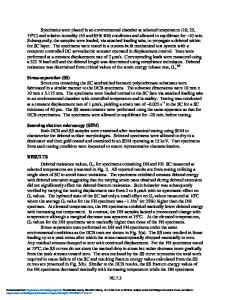Mechanical properties of stratum corneum studied by nano-indentation
- PDF / 162,125 Bytes
- 8 Pages / 612 x 792 pts (letter) Page_size
- 84 Downloads / 433 Views
G10.2.1
Mechanical properties of stratum corneum studied by nano-indentation Yonghui Yuan and Ritu Verma, Unilever Research, Edgewater, NJ, 07020 Abstract Stratum corneum acts as a barrier to protect our body, as well as a pathway for conducting skin sensations. Understanding the mechanical properties such as elasticity, yield stress, of stratum corneum is important to improve and develop new products in the personal care industry. In this work, structural properties of stratum corneum are studied by atomic force microscopy (AFM) imaging to reveal surface structure of stratum corneum. To study mechanical properties, AFM force measurements and nanoindentation techniques were used to characterize elastic properties of dry and wet stratum corneum. Nano-DMA measurements were also conducted to characterize visco-elastic properties of the same material. 1. Introduction Stratum corneum (SC) is the outmost layer of skin, which acts as a barrier to protect our body from harsh environmental factors. It is also the gateway for sensations such as pressure, heat, and cold, which are detected by specific nerves that lie in the skin under the epidermis. The average thickness of stratum corneum is about 20 µm, and it is composed of corneocytes, which are dead cells from the epidermal layer. Each corneocyte is about 500 nm thick and 40-50 µm in diameter. They are held together by lipid structures in what is commonly referred to as a brick-and-mortar structure. This microstructure typically leads to a complex visco-elastic material, which has been the focus of many studies. The focus of this research study is to understand the mechanical properties of the stratum corneum at the sub-micro to micro levels. Previous experiments in this area are clustered around clinical techniques such as ballistometer, cutometer, etc. (1). These techniques are macroscopic in nature, and extract properties of skin in its entirety. However, environmental and chemical interactions first affect the stratum corneum microstructure, which leads to larger mechanical changes in our skin. Studies focusing on mechanical changes of stratum corneum have included fracture measurement on stratum corneum by Dauskardt et al. (2), and ultrasound investigations by Srinivasan et al. (3). We present the first micro-scale study of stratum corneum using a range of mechanical probe microscopy techniques. Our studies are carried out under both quasi-static and dynamic conditions. The quasistatic tests were conducted by nano-indentation using an AFM and a nano-indentor. The dynamic studies were carried out by a nano-DMA. These techniques are ideally suited for measuring compression moduli of thin layers such as stratum corneum. The effects of hydration are considered in these experiments. 2. Experimental methods 2.1 Stratum corneum sample preparation Porcine stratum corneum was prepared by the method described in Golder et al. (4), in which the SC was separated from the underlying tissue by trypsin treatment. Then a piece
G10.2.2
of stratum corneum was glued to a glass slid
Data Loading...










